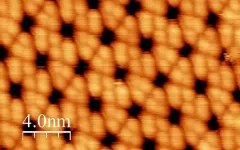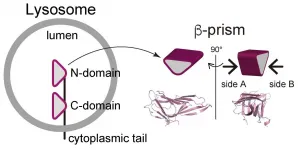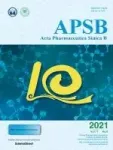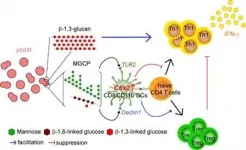(Press-News.org) ALBUQUERQUE, N.M. -- Like two superheroes finally joining forces, Sandia National Laboratories' Z machine -- generator of the world's most powerful electrical pulses -- and Lawrence Livermore National Laboratory's National Ignition Facility -- the planet's most energetic laser source -- in a series of 10 experiments have detailed the responses of gold and platinum at pressures so extreme that their atomic structures momentarily distorted like images in a fun-house mirror.
Similar high-pressure changes induced in other settings have produced oddities like hydrogen appearing as a metallic fluid, helium in the form of rain and sodium a transparent metal. But until now there has been no way to accurately calibrate these pressures and responses, the first step to controlling them.
Said Sandia manager Chris Seagle, an author of a technical paper recently published by the journal Science, "Our experiments are designed to measure these distortions in gold and platinum as a function of time. Compression gives us a measurement of pressure versus density."
Following experiments on the two big machines, researchers developed tables of gold and platinum responses to extreme pressure. "These will provide a standard to help future researchers calibrate the responses of other metals under similar stress," said Jean-Paul Davis, another paper author and Sandia's lead scientist in the effort to reliably categorize extreme data.
Data generated by experiments at these pressures -- roughly 1.2 terapascals (a terapascal is 1 trillion pascals), an amount of pressure relevant to nuclear explosions -- can aid understanding the composition of exoplanets, the effects and results of planetary impacts, and how the moon formed.
The technical unit called the pascal is so small it is often seen in its multiples of thousands, millions, billions or trillions. It may be easier to visualize the scale of these effects in terms of atmospheric pressure units. The center of the Earth is approximately 3.6 million times the atmospheric pressure at sea level, or 3.6 million atmospheres. Z's data reached 4 million atmospheres, or four million times atmospheric pressure at sea level, while the National Ignition Facility reached 12 million atmospheres.
The force of the diamond anvil
Remarkably, such pressures can be generated in the laboratory by a simple compression device called a diamond anvil.
However, "We have no standards for these extreme pressure ranges," said Davis. "While investigators see interesting events, they are hampered in comparing them with each other because what one researcher presents at 1.1 terapascals is only 0.9 on another researcher's scale."
What's needed is an underlying calibration tool, such as the numerical table these experiments helped to create, he said, so that scientists are talking about results achieved at the same documented amounts of pressure.
"The Z-NIF experiments will provide this," Davis said.
The overall experiments, under the direction of Lawrence Livermore researcher D. E. Fratanduono, relied on Z machine's accuracy as a check on NIF's power.
Z's accuracy, NIF's power
Z's force is created by its powerful shockless magnetic field, generated for hundreds of nanoseconds by its 20 million-ampere pulse. For comparison, a 120-watt bulb uses one ampere.
The accuracy of this method refocused the higher pressures achieved using NIF methods.
NIF's pressures exceeded those at the core of the planet Saturn, which is 850 gigapascals. But its laser-compression experiments sometimes required a small shock at the start of the compression wave, raising the material's temperature, which can distort measurements intended to set a standard.
"The point of shockless compression is to keep the temperature relatively low for the materials being studied," said Seagle. "Basically the material does heat as it compresses, but it should remain relatively cool -- hundreds of degrees -- even at terapascal pressures. Initial heating is a troublesome start."
Another reason that Z, which contributed half the number of "shots," or firings, and about one-third the data, was considered the standard for results up to 400 gigapascals was because Z's sample size was roughly 10 times as big: 600 to 1,600 microns thick compared with 60 to 90 microns on NIF. A micron is a thousandth of a millimeter.
Larger samples, slower pulses equal easier measurements
"Because they were larger, Z's samples were less sensitive to the microstructure of the material than were NIF's," said Davis. "Larger samples and slower pulses are simply easier to measure to high relative precision. Combining the two facilities really tightly constrained the standards."
Combining Z and NIF data meant that the higher-accuracy, but lower-intensity Z data could be used to pin down the low-to-medium pressure response, and with mathematical adjustments, reduce error on the higher-pressure NIF data.
"The purpose of this study was to produce highly accurate pressure models to approximately one terapascal. We did that, so this combination of facilities has been advantageous," said Seagle.
INFORMATION:
Sandia National Laboratories is a multimission laboratory operated by National Technology and Engineering Solutions of Sandia LLC, a wholly owned subsidiary of Honeywell International Inc., for the U.S. Department of Energy's National Nuclear Security Administration. Sandia Labs has major research and development responsibilities in nuclear deterrence, global security, defense, energy technologies and economic competitiveness, with main facilities in Albuquerque, New Mexico, and Livermore, California.
Sandia news media contact: Neal Singer, nsinger@sandia.gov, 505-977-7255
Tsukuba, Japan - Organic light-emitting diodes (OLEDs) are widely used in display technology and are also being investigated for lighting applications. A comprehensive understanding of these devices is therefore important if their properties are to be harnessed to their full potential. Researchers from the University of Tsukuba have directly observed the photoexcited electron dynamics in an organic film using time-resolved photoelectron emission microscopy. Their findings are published in Advanced Optical Materials .
OLED displays are popular because they are bright, lightweight, and do not consume a lot of power. Their output is generated when an exciton--a combination of an electron and an electron hole--releases its energy. However, this ...
Tokyo, Japan - A cell is composed of numerous organelles, each with a unique role that helps contribute to its overall functionality. The lysosome is an organelle that contains digestive enzymes and functions as a molecular garbage disposal and recycling center. Since the role of lysosome is crucial to maintain the cellular homeostasis, the lysosomal dysfunction causes neurodegenerative and metabolic diseases, cancer, as well as lysosomal storage disorders.
In a new article published in Autophagy, researchers at Tokyo Medical and Dental University (TMDU) performed a novel type of structural analysis to demonstrate how a certain molecular interaction is crucial for one lysosomal membrane protein to perform effectively.
LAMP1 (lysosomal-associated ...
LA JOLLA, CA--Chemists at Scripps Research have solved a long-standing problem in their field by developing a method for making a highly useful and previously very challenging type of modification to organic molecules. The breakthrough eases the process of modifying a variety of existing molecules for valuable applications such as improving the potency and duration of drugs.
The flexible new method, for "directed C--H hydroxylation with molecular oxygen," does what only natural enzymes have been able to do until now. It's described in a paper this week in Science.
"We ...
James Cook University scientists in Australia believe they have made a breakthrough in the science of keeping premature babies alive.
As part of her PhD work, JCU engineering lecturer Stephanie Baker led a pilot study that used a hybrid neural network to accurately predict how much risk individual premature babies face.
She said complications resulting from premature birth are the leading cause of death in children under five and over 50 per cent of neonatal deaths occur in preterm infants.
"Preterm birth rates are increasing almost everywhere. In neonatal intensive care units, assessment of mortality risk assists in making difficult decisions regarding which treatments should be used and if and when treatments are working effectively," said Ms Baker. ...
RICHLAND, Wash.--Earth bears many signs of human influence, from warming that exceeds pre-industrial temperatures to a rising sea. Add to that list, now, the human influence on the timing of Earth's water cycle, revealed by a new study led by researchers at the U.S. Department of Energy's Pacific Northwest National Laboratory.
The research, published this week in the journal Nature Climate Change, peels back layers of climatological noise to uncover a clear signal: from 1979 to 2019, increases in greenhouse gases and reductions in human-generated aerosols triggered an approximate four-day delay in seasonal rainfall over tropical land and the Sahel. The lag could mean delayed crop production, ...
We can generally recognize an object, even if it is presented for a very brief time. However, if another object appears immediately following the first object, the perception on the first object is impaired such that we do not notice its existence. This perceptual phenomenon, called "visual backward masking," is used in vision science to study how visual perception is processed in the brain. Interestingly, this phenomenon occurs even if the second object does not spatially overlap the first object, such as a contour or four dots surrounding the object.
The occurrence of this phenomenon is assumed to be due to a disruption of "feedback processing." When we see something, visual ...
In 2021 Acta Pharmaceutica Sinica B (APSB) is celebrating its 10th anniversary. The journal was founded with the goal of creating a global high-level forum centred around drug discovery and pharmaceutical research/application. APSB was included by Chemical Abstracts in 2011, accepted by PubMed Central in 2015, indexed by Science Citation Index in 2017 and has evolved to become one of the most important international journals in the field of pharmaceutical sciences.
Volume 11, issue 6 is a special issue marking the beginning of a series of celebratory events ...
The development of therapeutic drugs for inflammatory bowel disease, an intractable immune disease, and multiple sclerosis - an autoimmune disorder - is gaining traction. A research team from the Department of Life Sciences at POSTECH and a joint research team at ImmunoBiome Inc. have uncovered that a yeast-derived polysaccharide mixture inhibits the onset and progression of immune disorders.
The number of cases of Crohn's disease and ulcerative colitis - both inflammatory bowel diseases - in Korea was about 18,000 and 37,000 respectively as of 2019, increasing about 2.3 times ...
With a goal of breeding resilient crops that are better able to withstand drought and disease, University of California San Diego scientists have developed the first CRISPR-Cas9-based gene drive in plants.
While gene drive technology has been developed in insects to help stop the spread of vector-borne diseases such as malaria, researchers in Professor Yunde Zhao's lab, along with colleagues at the Salk Institute for Biological Studies, demonstrated the successful design of a CRISPR-Cas9-based gene drive that cuts and copies genetic elements in Arabidopsis plants.
Breaking ...
Tsukuba, Japan - The COVID-19 pandemic has changed the way people eat, work, shop and go to school. Now, researchers from Japan have found surprising differences in the way people use healthcare services--including house calls from doctors.
In a study published this month in BMC Emergency Medicine, researchers from the University of Tsukuba have revealed that patterns in illness type and severity did change during the pandemic--with unexpected trends that may tell us about how people use health care services when personal contact carries inherent risk.
In Tokyo, private after-hours house call services (AHHC) provide in-home medical service outside of regular ...






